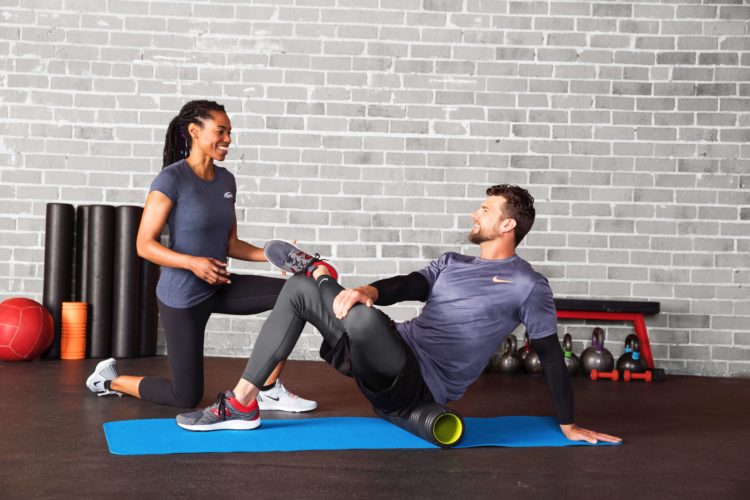Knee pain is common in physically active males and females. According to a new clinical guideline in the Journal of Sports Physical Therapy examining patellofemoral pain, approximately 25% of individuals will suffer from idiopathic (no specific onset) knee pain. In younger populations, knee pain is prevalent between the ages of 12 and 19 years old, with females more susceptible than males (Callaghan & Selfe, 2007; Willy et al., 2019).
Several common types of injuries are associated with the knee. Injuries can occur either from a traumatic injury resulting in fractures, dislocations or torn ligaments, or a gradual onset. Most active individuals experience knee pain with a gradual onset, resulting in pain on or around the patella (knee cap).
These individuals also present with specific movement impairments. These impairments, from a biomechanical perspective, include muscular weakness in the hips and surrounding knee musculature. These result in a knee valgus position (knee uncontrollably moves inward towards the other) in commons tasks such as squats, step-ups, running, jogging, cutting, and jumping.
While each individual needs to consult a licensed medical professional before implementing any targeted programming, those who are limited by anterior knee pain (pain on the front of the knee) may benefit from the following corrective exercise program example. The program follows NASM’s OPT model and focuses on improving mobility, stability, and strength in the musculature above and below the knee joint.
Warm-Up
| Exercise | Photo | Duration |
| Self-Myofascial Release: Calves |  |
Perform on each leg, hold on tender area for 30-90 secs |
| Self-Myofascial Release: Adductors |
 |
Perform on each leg, hold on tender area for 30-90 secs |
| Self-Myofascial Release: IT Band/TFL |  |
Perform on each leg, hold on tender area for 30-90 secs |
| Self-Myofascial Release: Hamstrings |

|
Perform on each leg, hold on tender area for 30-90 secs |
| Static Stretch: Calves |  |
Perform 2x each leg, holding for 30 secs each side |
| Static Stretch: Adductors |

|
Perform 2x each leg, holding for 30 secs each side |
| Static Stretch: Hamstrings (Biceps Femoris) |  |
Perform 2x each leg, holding for 30 secs each side |
Resistive Training
| Exercise | Photo | Sets/Reps/Tempo | Notes |
| Wall Slides | 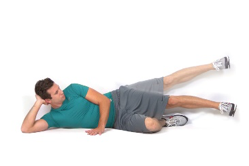 |
Perform 2 sets of 15 repetitions for each leg at a slow tempo | Position yourself with your back flush against a wall; knee in a locked position and pressing your heel into the wall. Slowly raise your leg, maintaining heel pressure into the wall and then lower |
| Ball Bridge | 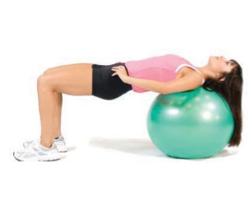 |
Perform 2 sets of 15 repetitions at a slow tempo | Position the ball between your shoulder blades; feet shoulder width apart and toes straight forward. In a slow and controlled movement, bring your hip up towards the ceiling, making sure the ball does not move. Once your body is parallel to the ground, hold this position for 2 secs and then lower your hips back down |
| Lateral (Side) Tube Walk | 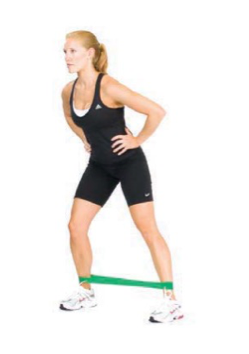 |
Perform 2 sets of 15 repetitions at a slow tempo in each direction | Place a resistance band around your ankles. Start with your toes straight forward and feet shoulder width apart and in an athletic position. While maintaining an upright posture, take a step to the right. Next, bring your opposite foot towards the other. Continue this side-stepping position for 15 steps. Repeat going to the left. |
| Step-Up to Balance | 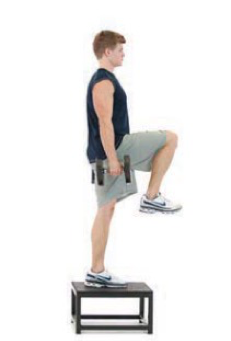 |
Perform 2 sets of 15 repetitions at a slow tempo for each leg | Using a box or a step, take a step forward onto the box and drive your opposite leg forward into a 90/90 position. Hold this position for 2 secs while actively contracting your quadriceps muscles and gluteus maximus muscle on your balance leg. Slowly step completely off the box. Repeat for 15 repetitions before moving to the other leg. Note: this exercise can be completed with or without weight. |
| Single Leg Squat | 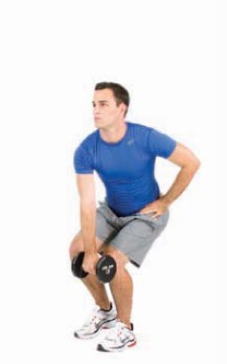 |
Perform 2 sets of 15 repetitions at a slow tempo for each leg | With your toes pointed straight forward, your non-balance leg maintaining a position right next to the other and balancing on one leg, slowly squat down, keeping your knee in line with your 2nd and 3rd toes, and preventing the knee from moving forward over the toes. Squat down as low as you can without losing control and form, but no more than 90 degrees of knee flexion. Hold this position for 2 secs and then stand back up. Repeat this exercise for 15 repetitions before moving to the other leg. |
| Single Leg Hop to Stabilization | 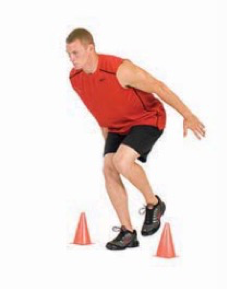 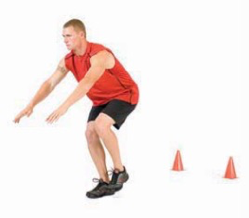 |
Perform 2 sets of 15 repetitions for each leg | With your toes pointed forward, balance on 1 leg, jump forward and land on the same leg as you used to jump. As you land, you should try to land “soft” by bending your knee. Maintain proper balance for 2 secs when you land, keeping your knee in line with your 2nd and 3rd toes and behind the front of your toes. Note: If you are having trouble with this exercise, start with a very small jump forward and then progress in distance when you can maintain proper form. |
Cool-Down
| Exercise | Photo | Duration |
| Self-Myofascial Release: Calves |  |
Perform on each leg, hold on tender area for 30-90 secs |
| Self-Myofascial Release: Adductors |
 |
Perform on each leg, hold on tender area for 30-90 secs |
| Self-Myofascial Release: IT Band/TFL |

|
Perform on each leg, hold on tender area for 30-90 secs |
| Self-Myofascial Release: Hamstrings |

|
Perform on each leg, hold on tender area for 30-90 secs |
| Static Stretch: Calves | 
|
Perform 2x each leg, holding for 30 secs each side |
| Static Stretch: Adductors |

|
Perform 2x each leg, holding for 30 secs each side |
| Static Stretch: Hamstrings (Biceps Femoris) |  |
Perform 2x each leg, holding for 30 secs each side |
Conclusion
Knee pain is a common occurrence in an active population.
While it may seem counterintuitive to exercise when you are experiencing pain,
literature supports the practice of targeted hip and knee exercises,
specifically the muscles of the posterolateral hip (Willy et al., 2019).
This sample program should be implemented at least three times a week for 4 weeks. Seek the consultation of a licensed medical provider prior to beginning any exercise program.
Read also: Exercises to Alleviate Lower Back Pain| Exercises for Alleviating Shoulder Pain
References
Callaghan, M. J., & Selfe, J. (2007).
Has the incidence or prevalence of patellofemoral pain in the general
population in the United Kingdom been properly evaluated? Physical Therapy in Sport, 8(1), 37-43. doi:https://doi.org/10.1016/j.ptsp.2006.07.001
Willy,
R. W., Hoglund, L. T., Barton, C. J., Bolgla, L. A., Scalzitti, D. A.,
Logerstedt, D. S., . . . McDonough, C. M. (2019). Patellofemoral Pain. Journal of Orthopaedic & Sports Physical
Therapy, 49(9), CPG1-CPG95. doi:10.2519/jospt.2019.0302

